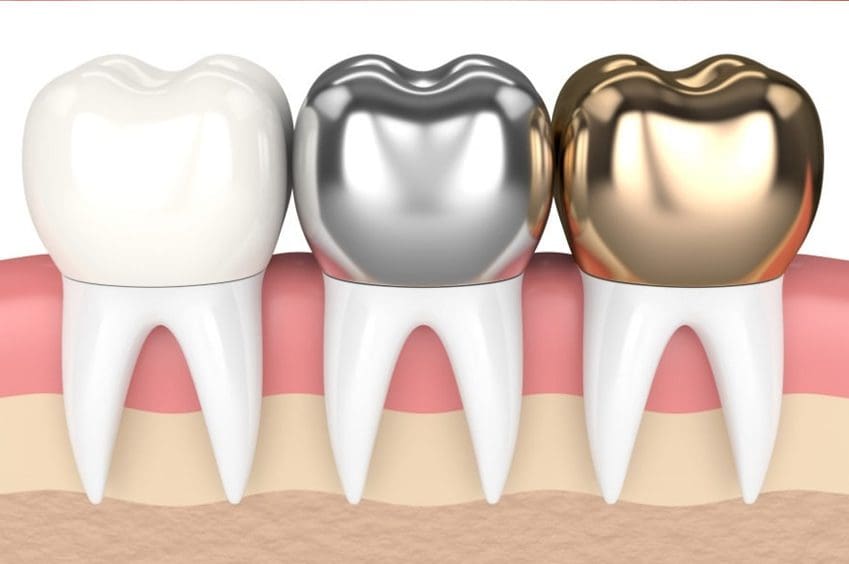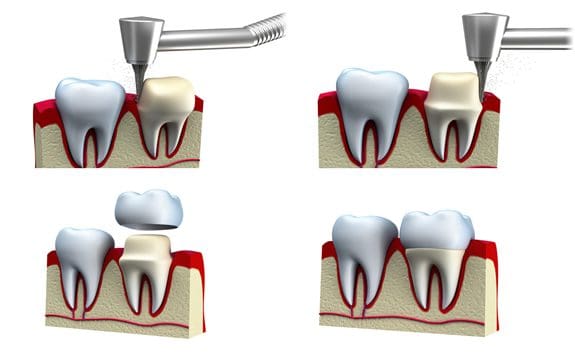
Dental crowns, also known as “caps,” preserve the functionality of damaged teeth. A dental crown may be used to protect a cracked tooth, restore functionality of a tooth with excessive decay or replace a pre-existing crown. The purpose of a dental crown is to encase a needy tooth with a custom-designed material. When evaluating potential dental crown cases, Dr. Streelman will examine the tooth for decay to ensure the crowned tooth will be healthy. If the tooth is free of decay, it will be roughened for a secure fit and an impression of the tooth’s surface will be made.
During the dental crown procedure, your dentist prepares the tooth and makes a molded impression of the teeth to send to a dental laboratory. A fitted, temporary crown is created during this visit to temporarily protect the tooth while the final restoration is being made in the dental laboratory. Once completed, the tooth crown is cemented or adhesively bonded at a later visit.

Fixed partial dentures (aka dental bridges) are an extension of the dental crown treatment for replacement of missing teeth. Crowns are placed on the teeth adjacent to the missing tooth or teeth and connected to a missing tooth-like replica. Although fixed partial dentures may serve as a functional and esthetic restoration, today’s treatment-of-choice for a missing tooth or teeth is with dental implants. A dental implant replaces missing teeth with a titanium root replica. A crown is then placed on the implant above the gumline. Dental implants are a very predictable treatment choice, returning support to the bite and preventing the need for the unnecessary crowning of adjacent teeth.
The three predominant choices of restorative materials for the full coverage crowns are:
The material selected is determined by the clinical demands at hand; esthetic demands, strength requirements, material durability and restorative space available.
Porcelain-fused-to-metal crowns provide for a strong, durable, and esthetic treatment option. One of the key factors for the esthetic and functional success of this type of crown is ensuring the preparation of the underlying tooth structure provides adequate space for the appropriate thickness of the material selected. Additionally, the artistic skill of the laboratory technologist creating the crown will determine its esthetic appeal.
One consideration in the porcelain-fused-to-metal crown is that these crowns may tend to show the underlying metal or gold margin at the gum line as gums recede over time. Some patients opt for this type of crown, but replace the crown at a later date in order to maintain a higher esthetic benefit. Porcelain-fused-to-metal crowns with an all porcelain collar can eliminate this vulnerability.
The predominant material choice for all-ceramic crowns today is either zirconia, or aluminous materials. They provide a metal-free esthetic option with a number of benefits.
By eliminating the need for the supportive metal core, an esthetic all-ceramic crown can be created with a reduced thickness of material. This makes them a more favorable treatment choice in areas with limited space. Additionally, the elimination of the metal core allows for light transmission through the porcelain for better optical, life-like properties and a higher level of esthetics.
All-ceramic materials continue to evolve in strength and durability, but caution should still be exercised for areas of the mouth requiring heavy function.
Although not as popular a treatment choice for esthetic reasons, gold crowns are still indicated in some instances. For example, patients with strong bites and those with parafunctional habits (such as grinding or clenching) might be better served with a gold crown. The traditional restorative material can provide stronger support to the remaining healthy tooth structure. Gold crowns offer a level of durability that is appropriate for teeth located in the back of the mouth (such as the molars), where they will not be highly visible. Gold crowns tend to offer greater longevity and require less preparation than porcelain and porcelain-fused-to-metal crowns. When chewing, gold tends to be less abrasive to the opposing tooth than porcelain. This helps to prevent wearing of the teeth.
We accept most dental insurance plans and we are also pleased to offer easy, NO INTEREST financing if you do not have insurance or if your insurance plan will only provide partial coverage.
Visit Dr. Steven Streelman at his state-of-the-art facility in Oceanside, CA to discuss whether or not a dental crown is the right option for you. To learn more about crowns, call us at (760) 439-0600 or click here to request an appointment online.
Monday-Wednesday
08:00 AM - 05:00 PM
Thursday
07:00 AM - 04:00 PM
Saturday & Sunday
Appointments Only